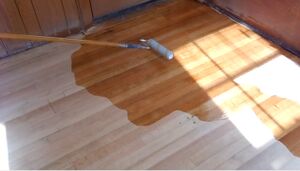Aliphatic Urethane
Aliphatic Urethane is a general purpose urethane we sell. It is comparable to oil-based urethanes (but different - do NOT add Mineral Spirits). It is normally a clear resin, but can be purchased in colours, and colour matched. It is a two part resin, one part resin, one part hardener. It is mixed in 2:1 proportions, of 2 Resin for each 1 Hardener. The Resin is part A, the hardener part B respectively.
Common applications for Urethane include coating on top of hardwood floors, concrete, metal, and epoxy finished floors.
Safety
Urethane is flammable. Use Urethane in a well ventilated area. Some form of dust mask or breathing protection is recommended.
Application Overview
- Prepare Surface to be coated
- Make sure temperature is at an appropriate level (at or above 65 deg F)
- Mix Urethane resin and Hardener
- Apply with a 3/16-inch Nap roller. Use a brush for hard to reach areas
- Wait 12 hours for the Urethane to cure
- If necessary, Sand urethane, and apply at least a 2nd coat.
A more detailed overview of how to apply Advance Coatings urethane can be found in the Aliphatic Urethane Data Sheet.
How to Apply Urethane
First, the surface to be coated should be prepared. This will depend upon your environment. As an example, an oak wood floor would be sanded down to virgin wood, and any damaged wood, cracks, or divots would be repaired. Optionally, a stain may or may not be applied.
Second, you must ensure the temperature is at an appropriate level. Urethane should not be applied if the area temperature is below 60-65 degrees fareinheit. If the temperature is too low, you can use room heaters. Choose heaters that do not emit any sparks or flames, as the Urethane is flammable.
Once the area is prepared, You can mix the Urethane and the Hardener. They are mixed in a 2:1 ratio, with two parts Urethane, to 1 part Hardener. The Urethane can be applied using the roller. To get a proper layer thickness, we recommend a 3/16-inch Nap Roller. A brush can also be used. Once the first coat is applied, the Urethane will cure in 12 hours at 65 deg. F. A minimum of two coats is advised. There is no maximum. Sand in-between coats with a pole sander, if necessary. The goal is to roughen up the previous layer, so that the next layer will be able to 'bite' or grab on. You also want to remove any dirt or materials that might have gotten into the Urethane when it was curing, or any high spots. Avoid drafts, or outdoor wind that might bring in dirt to the surface.
Futher details can be found in the example use case scenarios.
Tips
Avoid Thick Coats of Urethane
If Urethane is applied in too thick of a layer, it will not cure correctly. You can build up a thick layer of urethane, but it must be over a period of multiple coats. A 3/16-inch roller provides the right amount of thickness. This is due to how the Urethane cures. There is two reactions - a surface cure, and an internal chemical reaction between the resin and hardener. When you put a thick layer down, the two reactions happen at inconsistent speeds.
The Second Coat of Urethane may Require Less than the First
For example, when doing a hardwood floor, the first coat will require a bit more, perhaps 15% more Urethane as the wood will soak much of the first (primer) coat. The second coat will use less urethane, therefore less can be made, and less can be poured down at a given time for this 2nd coat.
Do not mix Aliphatic Urethane and Mineral Spirits
Unlike common oil based Urethanes used for wood finishing (Minwax, Fabulon), you can NOT add mineral spirits to this Aliphatic Urethane. Doing so will result in a cloudy cure. There is no need to thin this urethane in order to avoid bubbling, as it rarely bubbles.
Aliphatic Urethane vs. Water vs. Oil based Urethane Hardwood Floor Colour
The appearance of hardwood under Aliphatic Urethane is somewhere between oil and water based Urethanes, with a strong lean towards the oil based Urethanes known for their gold colour on woods such as Oak. For an example, see this Red Oak floor before and after picture with Aliphatic Urethane.
Curing Urethane can Attract Flying Bugs
It is best to use a window with a screen, to offer some ventilation when curing Urethane. Having an open door or window, may cause flying bugs to be attracted to the aroma. If a bug or dirt is caught in a coat of urethane, it can be rubbed or sanded out, with additional urethane applied on top.
Sanding Urethane is Not Always Required Between Coats
If the primer coat of Urethane is rough enough, a 2nd coat can be applied without sanding. Some experience and judgment should be exercised here.
Use a Solvent to Clean Urethane off of Hands or Tools
A solvent, such as Acetone can be used to clean urethane off of tools and hands after working.
